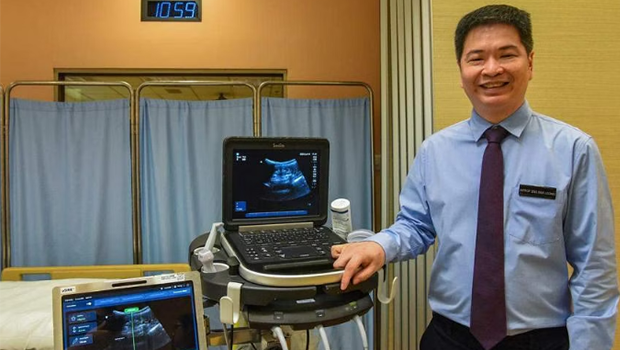
Associate Professor Sng Ban Leong with the world's first artificial intelligence-powered ultrasound guided automated spinal landmark identification system. ST PHOTO: EUGENE TAN
An artificial intelligence-powered ultrasound system is helping doctors at KK Women's and Children's Hospital (KKH) to better deliver spinal anaesthesia on the first try for women who give birth via caesarean section.
The technology especially benefits obese patients with a body mass index of over 30 as well as those who have an abnormal spine, as it is more challenging to detect the correct spot for injection, said senior consultant Sng Ban Leong, who heads the department of women's anaesthesia at KKH.
The system, called uSine, is developed by KKH, medical device company HiCura Medical, and the Department of Electrical and Computer Engineering at National University of Singapore.
Spinal anaesthesia procedures involve delivering local anaesthetics into a fluid space surrounding the spinal canal. This involves locating the correct needle insertion spot and angle.
Typically, a doctor uses his hands to feel for spinal landmarks to identify the spot for needle insertion, which is in the lower spine, between the L3 and L4 lumbar vertebrae.
"This requires good knowledge of the anatomy, skills and experience due to the complexity of the procedure… This is usually very challenging in patients with high body mass index because the spinal structures will not be that obvious," said Associate Professor Sng.
Studies have shown that about 10 per cent of women in Singapore are obese during pregnancy.
The manual method has a success rate of about 70 per cent in women with healthy weight, and 43 per cent for women who are obese, for achieving spinal anaesthesia at the first attempt.
With the new system, the success rate has jumped to 92 per cent for women in the healthy weight range, and 82 per cent in obese women.
uSine uses a proprietary machine learning algorithm, which has been trained with images of spinal structures to identify anatomical landmarks.
Doctors use the ultrasound system, scanning a patient's spine vertically and horizontally to look for the right spot for injection. Upon detection, the machine plays a short tune to alert the anaesthetist to the location and angle of insertion for the needle.
Prof Sng said the technology will benefit the majority of patients giving birth via caesarean section, as they would need spinal anaesthesia.
Being able to get the injection right the first time "improves the quality of anaesthesia and reduces complications such as nerve irritation, blood collection within the tissues in the spine or, in rare cases, neurological injury", he added.
KKH performs more than 3,500 spinal anaesthesia procedures each year.
Clinical trials involving about 200 patients started in 2017, and were funded by grants from the National Health Innovation Centre and National Medical Research Council.
uSine was eventually implemented in KKH in May 2023, and is licensed to HiCura Medical for commercialisation.
Prof Sng said there are plans to introduce the system to other healthcare institutions in Singapore, starting with those within SingHealth as early as this year.
Trials are also planned for Australia, the United States and Europe.













 Get it on Google Play
Get it on Google Play